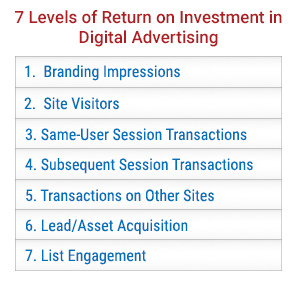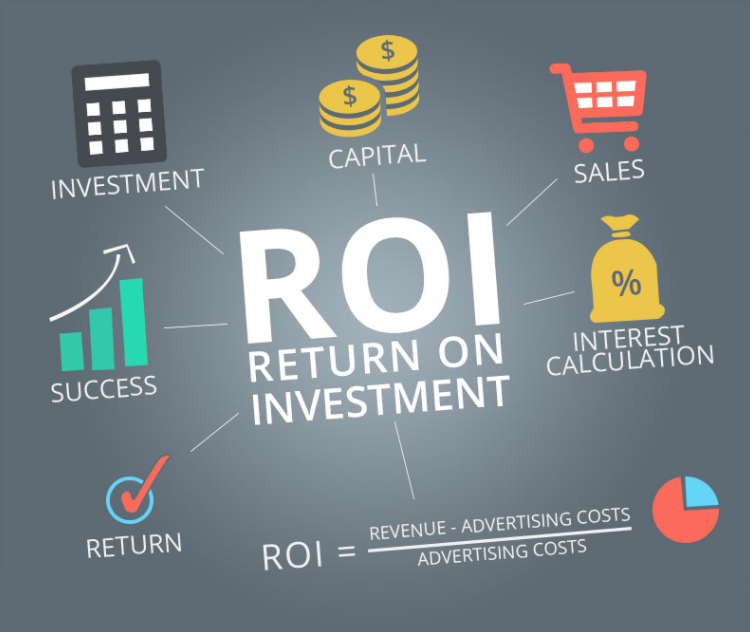It doesn’t take much math to discover that ROI in online advertising can be evasive, particularly if you measure return on a sale completed in the same-user session that started with the click on an ad.

So when advertising leads to a guaranteed loss, what’s to be concluded? Stop advertising altogether? Hardly a path to business progress.
The answer? Reframing ROI in online advertising and recasting objectives is a better path to getting back resources invested in online promotions.
Consider these seven paths to capturing a return:

- Branding impressions 100,000 banners sporting your logo, brand, and message seen by 20,000-30,000 users has definite value—though usually an insufficient result to justify an advertising spend.
- Visits to your site (following a click on your ad) Compared to the micro-second glimpse of a branding impression, a visit to your site is arguably a hundred times more valuable. The user takes action in your direction with a click, hopefully spending several minutes and viewing several pages on your site. This heightened awareness of your product greatly multiplies the user’s propensity to buy.
- Same-user session transactions (sales, donations, captures) The most common measure for effective return on investment in online advertising is a transaction made during the visit initiated by a clicked-on ad.
- Low price point? (Books and products selling for $10–$50)ROI: Virtually impossible to recoup the ad spend. See the math above.
- Moderate price point? (Digitally delivered resources selling for $100–$200 with an aggressive value proposition)ROI: Reasonable to pursue a break-even ROI when measuring same-user session sales
- High price point? (A college education, jet airplanes, and buildings valued in the hundreds of thousands or millions of dollars)ROI: A much more attainable goal—but NEVER in the same user session. The higher the price point, the longer the selling cycle.
Conclusion: Same user session transactions are the wrong (solitary) measure for ROI in online advertising.
- Subsequent-user session transactions on your own site What if they don’t buy the first time? Well, there might be a sale on their next visit. $10,000 Hint: If you don’t get their email address and initiate the next visit, they are very unlikely to come back to your site for a future transaction.
- Subsequent transactions on other sites Perhaps you retail on your own site. Perhaps your other distribution channels also sell your product. Twenty books sold on your site combined with 140 books sold on other sites (Amazon, Barnes & Noble, ChristianBook.com, etc.) gives ROI measured by traceable sales a fighting chance.
- Captured email addresses and other contact information Consider the power of capturing contact information: You are no longer subject to passively hoping for a return visit and future sales. You can now initiate follow-up contacts and trigger multiple visits to your site, not just for the initially advertised product, but (if properly permissioned) for dozens of other products you might offer.One hundred captured emails engaged in weekly follow-up contacts equals over 5,000 touches beyond the initial 200 visits exemplified above. (Yes, 100 captures from 200 visits is possible!)
- List engagement The value of a permissioned email address effectively engaged is arguably worth $5–$10 per year that address remains on your active list. Growing your list not only drives sales in the short term. It is the development of a long-term valued asset.On the other hand, a list of 10,000 email captures left unengaged won’t do much good.Three principles of list engagement:
- More frequent is better for your list than less frequent. Many factors impact frequency (diversity of products, nature of content, effectiveness of your initial email welcome sequence, etc.). Infrequent contacts tend to damage the value of your list more than more frequent contacts.
- Make sure the content you send is fresh and compelling to the audience you are targeting. Fifty-two touches with the same boring message is a recipe for failure. Fifty-two touches with a diversity of editorial content, product messages, and compelling special offers promise much more productive list engagement.
- Choose your subject lines, headlines, and article titles carefully. A 23% open rate is typically preferred over a 6% open rate! (For more information on crafting subject lines, read “6 Tips for Writing Email Subject Lines that Engage and Electrify.”)
It is possible to attain an abundant return in an online advertising investment. It’s most likely to happen if you employ effective user-engagement techniques and if you include data capture as an explicit objective of your advertising campaign and broader marketing strategy.
